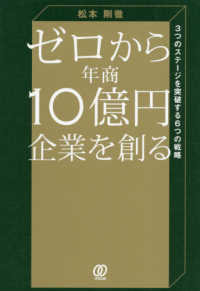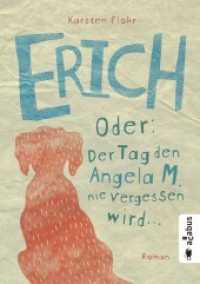Full Description
The first invasive evaluation of cardiac arrhythmias in humans was performed in 1967 in Paris (Prof. P. Coumel) and Amsterdam (Prof. D. Durrer). This was the start of a rapid increase in our knowledge of the diagnosis, mechanism and treatment of cardiac arrhythmias. In that same year Prof. Hein J.J. Wellens became cardiologist in the Wilhelmina Gasthuis in Amsterdam. Initially in Amsterdam (1967-1977) and later on in Maastricht (from 1977), he was the driving force for many breakthroughs in clinical cardiac electrophysiology. With an active interplay between the knowledge derived from the 12-lead electrocardiogram and the recordings made with invasive electrophysiology, he composed new ideas leading to major contributions in clinical cardiac electrophysiology and, more generally, in arrhythmology. He published over 650 scientific papers and 14 books, and had numerous functions within scientific boards of prestigious journals. In addition he trained more than 120 cardiologists in clinical cardiac electrophysiology.
On the occasion of the congress `2000, Future of Arrhythmology: Lessons From the Past, Promises For Tomorrow', we highlight the scientific work of Prof. Hein J.J. Wellens. A selection of more than 60 articles over the whole time span has been selected. These articles are accompanied by comments from an expert, co-worker and/or former fellow in order to place the paper in a scientific time frame, including the relationship of the author with Prof. Hein J.J. Wellens.
Contents
Introduction; F.L. Meijler. 1. The role of premature beats in the initiation and the termination of supraventricular tachycardia in the Wolff-Parkinson-White syndrome; D. Durrer, et al. 2. Supraventricular tachycardia with left aberrant conduction due to retrograde invasion into the left bundle branch; H.J.J. Wellens, D. Durrer. 3. Electrical stimulation of the heart in patients with Wolff-Parkinson White syndrome; Type A; H.J.J. Wellens, et al. 4. Electrical stimulation of the heart in patients with ventricular tachycardia; H.J. Wellens, et al. 5. Ventricular fibrillation occurring on arousal from sleep by auditory stimuli; H.J. Wellens, et al. 6. Effect of digitalis on atrioventricular conduction and circusmovement tachycardias in patients with the Wolff-Parkinson-White syndrome; H.J.J. Wellens, D. Durrer. 7. Further observations on ventricular tachycardia as studied by electrical stimulation of the heart. Chronic recurrent ventricular tachycardia and ventricular tachycardia during acute myocardial infarction; H.J. Wellens, et al. 8. Factors influencing prognosis of bundle branch block complicating acute anteroseptal infarction. The value of His bundle recordings; K.I. Lie, et al. 9. Epicardial mapping and surgical treatment in Wolff-Parkinson-White syndrome; Type A; H.J.J. Wellens, et al. 10. Lidocaine in the prevention of primary ventricular fibrillation; K.I. Lie, et al. 11. W.P.W. syndrome and atrial fibrillation. Relation between refractory period of accessory pathway and ventricular rate during atrial fibrillation; H.J.J. Wellens, D. Durrer. 12. The role of an accessory atrioventricular pathway in reciprocal tachycardia; H.J.J. Wellens, D. Durrer. 13. Effect of Amiodarone in the Wolff-Parkinson-White syndrome; H.J.J. Wellens, et al.14. Observations on mechanisms of ventricular tachycardia in man; H.J.J. Wellens, et al. 15. Value and limitations of Thallium-201-scintigraphy in the acute phase of myocardial infarction; F.J.Th. Wackers, et al. 16. Effect of Procainamide, Propranolol and Verapamil on mechanism of recurrent ventricular tachycardia; H.J.J. Wellens, et al. 17. The value of the electrocardiogram in the differential diagnosis of a tachycardia with a widened QRS-complex; H.J.J. Wellens, et al. 18. The anatomical substrates of Wolff-Parkinson-White syndrome. A clinicopathologic correlation in seven patients; A.E. Becker, et al. 19. Reciprocal tachycardias using accessory pathways with long conduction times; J. Farré, et al. 20. Use of Ajmaline in identifying patients with the Wolff-Parkinson-White syndrome and a short refractory period of their accessory pathway; H.J.J. Wellens, et al. 21. Initiation and termination of ventricular tachycardia by supraventricular stimuli; H.J.J. Wellens, et al. 22. Spontaneous termination of circus movement tachycardia utilizing an atrioventricular accessory pathway: incidence, site of block and mechanisms; D.L. Ross, et al. 23. Characteristic electrocardiographic pattern indicating a critical stenosis high in left anterior descending coronary artery in patients admitted because of impending myocardial infarction; D. de Zwaan, et al. 24. Pacemaker related tachycardia; K. den Dulk, et al. 25. Inter- and intra-atrial dissociation d








